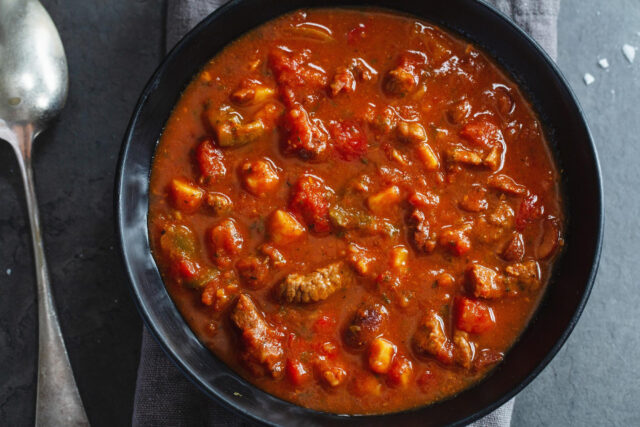Stifado is one of the most popular and recognizable dishes of Cypriot cuisine, a thick meat stew slowly simmered in wine, tomato sauce, and aromatic spices. This centuries-old recipe embodies the philosophy of the Cypriot table: leisurely preparation, simple ingredients, and a rich flavor created over time.

Contents
Origin and history of the dish
The name stifado comes from the Greek word stifado, meaning “stewed” or “steamed.” The dish’s roots date back to Byzantine times, when stewing meat in wine and onions was considered a method of preserving food. The recipe later spread to Cyprus and adapted to local ingredients and climate.
On the island, stifado has become a symbol of home comfort and festive feasts. It is prepared in large clay pots ( tavás ) for the whole family, especially in winter and on religious holidays, when several generations gather around the same table.
The Cypriot version differs from the Greek one in that it often uses not only beef, but also rabbit, goat, or octopus, depending on the region and season.
Features of the Cypriot version
The key feature of Cypriot stifado is the onion. It’s not just an ingredient, but the foundation of the flavor. The dish uses small, whole onions of the kolokota variety —about the size of a walnut. They’re not chopped, but fried whole until caramelized, after which the meat is added.
The second important element is wine. Cypriots use local dry or semi-sweet red wine, most often Maratheftiko or Ophelia, which imparts a soft, rich aroma to the dish. Sometimes they add a splash of Commandaria, a famous dessert wine, which enhances the sweet and spicy note.

Ingredients and spices
Stifado is built on the harmony of meat, wine, tomatoes, and spices. The classic Cypriot version is prepared using:
- meat (beef, veal, rabbit or octopus);
- small shallot or bell onion;
- olive oil;
- red wine;
- tomato paste or fresh tomatoes;
- wine vinegar;
- garlic;
- bay leaf;
- cinnamon;
- cloves;
- black pepper;
- sometimes – coriander seeds or oregano.
Cinnamon and cloves are essential spices. They impart a distinctive oriental flavor to the dish, distinguishing Cypriot cuisine from European cuisine. Balance of spices is key: the aroma should be deep but not overpowering.
Cooking process
Authentic stifado is cooked slowly and for a long time. This dish can’t be rushed: the longer the meat sits in the sauce, the tenderer it will become and the richer the flavor.
- Preparing the meat: Cut the beef or rabbit into medium-sized pieces, rinse, and pat dry.
- Frying the onions. Fry the onions whole in olive oil until golden brown.
- Adding meat. Add the meat to the onions and fry until golden brown.
- Seasonings and sauce. Pour in the wine and vinegar, add tomato paste, spices, salt, and a little water.
- Cover the pan and simmer over low heat for 1.5 to 3 hours, until the meat is tender and the sauce thickens.
Sometimes stifado is cooked in the oven, in a clay pot at 160–170°C for 2–3 hours. This method is considered more traditional, as the even heat allows the ingredients to “melt” together, creating a unique depth of flavor.

Varieties of stifado in Cyprus
Cypriot cuisine is varied, and stifado has several local interpretations:
- Rabbit stifado (Kouneli stifado) is a classic rustic dish. The rabbit meat absorbs the sauce beautifully, becoming tender, almost creamy.
- Beef stifado is a denser and richer dish, often prepared for holidays.
- Octopus stifado (Xtapodi stifado) is a unique seafood dish popular in coastal areas. Instead of wine, a little vinegar and olive oil are sometimes added, and tomato sauce remains a must.
- Goat stifado is traditional for mountain villages, where the meat of local goats is particularly aromatic.
Each region of Cyprus adds its own touch: in Paphos they add rosemary, in Limassol they add coriander, and in Troodos they add a touch of honey for a caramel flavor.
Side dishes and serving
Stifado is served on its own or with traditional Cypriot side dishes. The most common variations are:
- bulgur pilaf (purgouri) with onions and butter;
- cypriot potatoes fried with rosemary;
- rice, especially in urban versions;
- homemade bread or pita to soak up the thick sauce.

The dish is usually served hot in deep bowls or ceramic plates. At festive tables, stifado is accompanied by red wine, and in rural areas, by zivania, a homemade grape drink.
Taste and aroma
Stifado is a combination of tender, almost melt-in-your-mouth meat, sweet caramelized onions, and a thick sauce rich with wine and spices. Its flavor is multilayered: first, you notice the slight acidity of the wine and tomatoes, then the sweetness of the onions and the warm spice of cinnamon and cloves.
The aroma of the dish fills the home and becomes part of family memories. In Cypriot families, stifado is often called the “smell of winter”—the scent of comfort, celebration, and the anticipation of guests.
Role in Cypriot culture
In Cyprus, stifado is not just a meal, but a symbol of the home. It is prepared for christenings, name days, and large family gatherings. The dish is associated with care, as it requires time and attention, and the resulting dish is prized for its rich flavor and nutrition.
Stifado is a staple in many Cypriot tavernas, especially in mountainous and rural areas. Travelers who order it often note that the taste varies from village to village—in some it’s richly wine-like, in others spicy or slightly sweet. This is because each family has its own recipe, passed down from generation to generation.
Modern interpretations
Modern Cypriot chefs offer their own versions of classic stifado. Some restaurants use lamb, replacing the wine with pomegranate juice or adding balsamic vinegar for a piquant flavor. Vegetarian versions substitute mushrooms or eggplant for the meat, preserving the traditional spices and slow-simmering method.
However, the classics remain unrivaled: stifado is a dish that cannot be recreated in a hurry. Its flavor is revealed only when the ingredients are combined with time and patience.
Stifado is one of those dishes that embodies the essence of Cypriot cuisine: simplicity, natural ingredients, and respect for tradition. Its flavor combines the aroma of vineyards, the spices of the East, and the warmth of a family hearth. This dish conveys not only nutrition but also the history of the island—slowly, like the Cypriot sun itself, revealing its character in every bite.

















